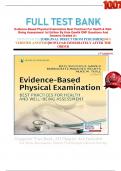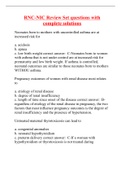Evidence-Based Physical Examination Best Practices For Health & Well-
Being Assessment 1st Edition By Kate Gawlik DNP Questions And
Answers Graded A+
PRINTEND PDF|ORIGINAL DIRECT FROM PUBLISHER|100%
VERIFIED ANSWERS|DOWLOAD IMMEDIATELY AFTER THE
ORDER
1TH EDITION
Complete Test Bank, All Chapter Are Included
For More Documents Search (Testbankproferssor.Stuvia)
, Table of contents
chapter 1. approach to evidence-based assessment of health and well-being ...3
chapter 2. evidence-based history-taking approach for wellnessexams, episodic visits, and chronic care
management ................................................................................................................................................. 17
chapter 3. approach to implementing and documenting patient- centered, culturally sensitive evidence-
based assessment .......................................................................................................................................... 33
chapter 4. evidence-based assessment of children and adolescents.............................................................. 50
chapter 5. approach to the physical examination: general survey and assessment of vital signs ................. 64
chapter 6. evidence-based assessment of the heart and circulatorysystem ................................................... 88
chapter 7. evidence-based assessment of the lungs and respiratorysystem ................................................. 109
chapter 8. approach to evidence-based assessment of body habitus(height, weight, body mass index,
nutrition) ..................................................................................................................................................... 129
chapter 9. evidence-based assessment of skin, hair, and nails .................................................................... 145
chapter 10. evidence-based assessment of the lymphatic system ............................................................... 168
chapter 11. evidence-based assessment of the head and neck .................................................................... 192
chapter 12. evidence-based assessment of the eye ..................................................................................... 212
chapter 13. evidence-based assessment of the ears, nose, and throat ......................................................... 231
chapter 14. evidence-based assessment of the nervous system .................................................................. 251
chapter 15. evidence-based assessment of the musculoskeletal system ..................................................... 278
chapter 16. evidence-based assessment of the abdominal,gastrointestinal, and urological systems .......... 302
chapter 17. evidence-based assessment of the breasts and axillae .............................................................. 320
chapter 18. evidence-based assessment of sexual orientation, genderidentity, and health......................... 343
chapter 19. evidence-based assessment of male genitalia, prostate,rectum, and anus ............................... 360
chapter 20. evidence-based assessment of the female genitourinarysystem ............................................... 380
chapter 21. evidence-based obstetric assessment ....................................................................................... 404
chapter 22. evidence-based assessment of mental health ........................................................................... 419
chapter 23. evidence-based assessment of substance use disorder ............................................................. 434
chapter 24. evidence-based assessment and screening for traumatic experiences: abuse, neglect, and
intimate partner violence ............................................................................................................................ 440
chapter 25. evidence-based therapeutic communication andmotivational interviewing in health assessment
.................................................................................................................................................................... 447
chapter 26. evidence-based history and physical examinations forsports participation evaluation ........... 472
chapter 27. using health technology in evidence-based assessment ........................................................... 493
chapter 28. evidence-based assessment of personal health and well- being forclinicians: key strategies to
achieve optimal wellness ............................................................................................................................ 508
chapter 29. evidence-based health and well-being assessment: puttingit all together................................ 528
,chapter 1. approach to evidence-based assessment ofhealth and
well-being
multiple choice
1. after completing an initial assessment of a patient, the nurse has charted that his respirations
are eupneic and his pulse is 58 beats per minute. these types of data would be:
a objective.
.
b reflective.
.
c subjective.
.
d introspective.
.
ans: a
objective data are what the health professional observes by inspecting, percussing, palpating,
and auscultating during the physical examination. subjective data is what the person says about
him or herself during history taking. the terms reflective and introspective are not used to
describe data.
dif: cognitive level: understanding (comprehension) ref: z. 2
msc: client needs: safe and effective care environment: management of care
2. a patient tells the nurse that he is very nervous, is nauseated, and feels hot. these types of
data would be:
a objective.
.
b reflective.
.
c subjective.
.
d introspective.
.
ans: c
subjective data are what the person says about him or herself during history taking. objective
, data are what the health professional observes by inspecting, percussing, palpating, and
auscultating during the physical examination. the terms reflective and introspective are not used
to describe data.
dif: cognitive level: understanding (comprehension) ref: z. 2
msc: client needs: safe and effective care environment: management of care
3. the patients record, laboratory studies, objective data, and subjective data combine to form
the:
a data base.
.
b admitting data.
.
c financial statement.
.
d discharge summary.
.
ans: a
together with the patients record and laboratory studies, the objective and subjective data form
the data base. the other items are not part of the patients record, laboratory studies, or data.
dif: cognitive level: remembering (knowledge) ref: z. 2
msc: client needs: safe and effective care environment: management of care
4. when listening to a patients breath sounds, the nurse is unsure of a sound that is heard. the
nurses next action should be to:
a immediately notify the patients physician.
.
b document the sound exactly as it was heard.
.
c validate the data by asking a coworker to listen to the breath sounds.
.
d assess again in 20 minutes to note whether the sound is still present.
.
ans: c
when unsure of a sound heard while listening to a patients breath sounds, the nurse validates the
data to ensure accuracy. if the nurse has less experience in an area, then he or she asks an expert
to listen.





